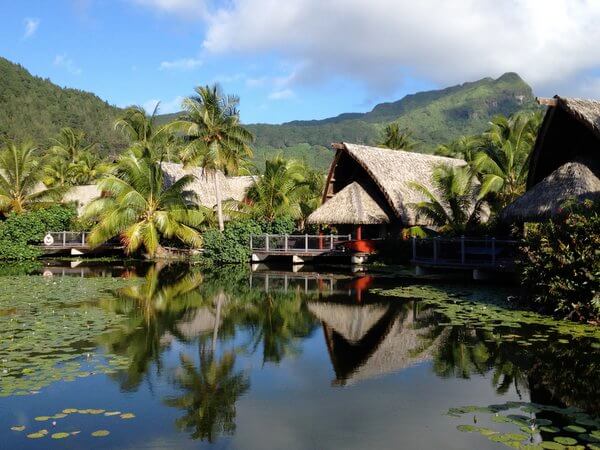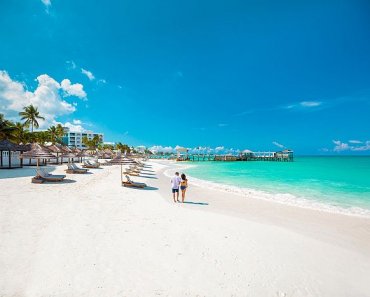I love a hotel with a story. The Hotel Maitai Lapita Village on the island of Huahine in French Polynesia has two.
One story began in the 1970s when a 12-year-old boy from California visited Tahiti with his family. That boy was Peter Owen, now the owner of the Lapita Village hotel. Owen became enamored with the islands and decided that someday, he would return.
Owen began studying pottery and at age 19, he realized his dream of returning to Tahiti, where he set up a pottery workshop. He married a Tahitian woman, and they eventually moved to Huahine, a relatively little-touristed island about 40 minutes by plane from Papeete. They opened the Huahine Pearl Farm, and Owen continued with his pottery work.
Fast forward a couple of decades. A former hotel property came up for sale, and Owen started a new career as a hotel owner. He’ll tell you, “I’m just a potter,” but he’s also the design vision behind this laid-back resort hotel, which opened in 2011.

Guest Rooms and Facilities
Owen wanted the hotel’s 32 thatch-roofed bungalows, constructed around a manmade lake in the center of the property, to be built in the style of Polynesian canoe houses. They’re gorgeous and simply huge, with soaring ceilings and thatched roofs. Traditional canoe paddles, known as hoe, hang from the walls.

The best rooms are the 15 “premium lake” bungalows, which have spacious lakeside decks that echo the canoe designs. Built-in furnishings, from local woods, provide ample storage space. Nightly rates for these premium lake units begin at 32,250 XPF (US$370).
Set behind the lake bungalows, the “premium garden” bungalows are similarly furnished, except that they lack the lakeside terraces and views. These bungalows start at 29,000 XPF (US$332) per night.
Also set back from the lake are the 12 slightly smaller, standard garden bungalows. Rates for these garden units start at 24,228 XPF (US$275).
All units have mini-fridges, safes, and flat-screen TVs. With a touch of the remote control, the TV rises out of a hidden compartment in a table facing the bed.
- Buy Travel Insurance
- Search for Great Tours HERE
- Get a Car Rental

In the lakeside bungalows, the bathrooms are especially large, too, with oversized sinks designed to echo the oval shape of traditional Tahitian canoes.

Location and Amenities
The Lapita Village is set on a white sand beach, right on the bluer-than-blue lagoon. You can walk along the beach to Fare, the island’s main town, in about 10 minutes (though if you’re walking at night, you might want to take a flashlight.)
That’s one of the things we especially enjoyed about the Lapita Village — its proximity to town. Unlike many resorts where the objective seems to be to shelter guests from the surrounding area, Lapita staff encourage guests to go off exploring. The hotel will arrange various tours and excursions, book rental cars or bicycles, and make suggestions of things to do nearby. Even on the night we arrived, the front desk staffer who welcomed us not only told us about dinner at the hotel, but also suggested heading into town to eat at one of the small local restaurants or roulottes (food trucks) that set up shop along Fare’s main street.

Restaurant and Bar
The hotel’s Omai Restaurant, in an open-air thatch-roofed space overlooking the pool and beach, serves breakfast, lunch, and dinner.
Room rates typically include the expansive breakfast buffet, where the highlights include croissants and other French pastries, fresh tropical fruits, French cheeses, and baguettes with tropical jams. With this French-Polynesian bounty, we didn’t even need the eggs, bacon, sausage, and pancakes that were also on offer.
At midday and in the evenings, popular dishes include poisson cru and sashimi, as well as several varieties of grilled fish.
Two evenings a week, the restaurant hosts a traditional Tahitian dance show, featuring local dancers and musicians.

Lapita History
Beyond the story of its owner Peter Owen, the Maitai Lapita Village has another story, too. That much-longer history is of the Lapita people, who were ancestors of the Polynesians. The present-day hotel site was once an ancient Lapita settlement; archeological excavations that began in the 1970s unearthed artifacts that date back over 1000 years.
A small museum in the hotel lobby tells the Lapita story and houses some of these historic artifacts. Also on the hotel grounds is a restored marae, or open air stone temple (pictured above).
In building the hotel, which was named for the Lapita people, owner Peter Owen says it was important to honor and preserve the Lapita history. He and the Lapita Village staff have managed to incorporate the Lapita story and heritage into this present-day resort.
Now that’s a story worth sharing.
Book directly through the hotel or through Hotels.com.
Looking for a hotel on Bora Bora, too? Though the style and atmosphere are very different than at the Huahine hotel, the Maitai group also runs the Hotel Maitai Bora Bora: Paradise on a (Mid-Range) Budget.
Hotel review by Vancouver-based travel, food, and feature writer Carolyn B. Heller, author of the books, Moon Handbooks: Ontario and Living Abroad in Canada. Photos © Carolyn B. Heller. I paid a discounted media rate for my stay at the Maitai Lapita Village.




